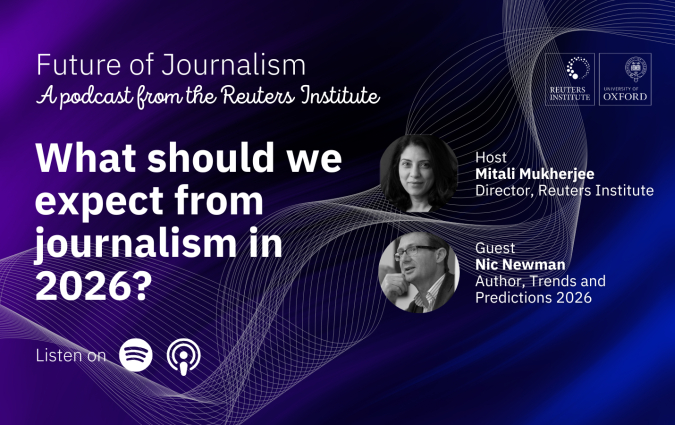As social media turns away from the news, publishers meet audiences on other channels

Elon Musk has turned Twitter (now known as X) into a much bleaker environment for journalism. The platform no longer displays headlines when posting links and is sending much less traffic to news organisations.
Some of Musk’s actions have been even more hostile. He added a "government funded" label to a few media outlets which prompted NPR and others to leave the platform. X suspended journalists that have gotten under Musk’s skin. An analysis found that the platform also throttled traffic to websites Musk disliked.
And yet X is not the only tech company breaking from the news. Meta has decisively disengaged from journalism, particularly on Facebook. They have dismantled their journalism programmes, stopped paying US news publishers for their content, reallocated resources away from the Facebook News project, and even retired the term ‘news feed’ in favour of ‘feed’. Most recently, they announced that they will remove a dedicated tab for news content in the UK, France and Germany, in addition to retreating from making news content available in Canada altogether.
In an industry still relying on social media for traffic and audience engagement, what does it mean when social media giants start pulling the rug out from under news? I spoke to journalists working for news publishers in the US, Europe and Latin America who have noted this trend and are diversifying their audience development mechanisms away from social media platforms.
News on the News Feed: a short history
Social media changed the way audiences consume, share and discover news. Today most people in most countries covered by our Digital News Report access news on their phones and on digital platforms. This was a huge paradigm shift and one to which news organisations struggled to adapt.
When Facebook introduced the News Feed in 2006, it was met with resistance from users concerned about their privacy. But journalism soon became part of the mix as users shared news content and publishers created strategies to get more traffic. At a conversation at Facebook headquarters in 2014, Mark Zuckerberg even declared that the idea for the News Feed was to build the “perfect personalised newspaper for every person in the world.” (A report commissioned by Meta in 2023 claims links to news stories account for less than 3% of what Facebook users around the world see in their feeds.)
Our Digital News Report chronicled this shift extensively. In 2012 its first edition revealed that Facebook was “the most important network for news” while pointing out that overall search engines were still more important than social media. By 2013, that assertion was already being challenged in a number of countries, with over 27% of respondents saying they used social media as a source of news. Three years later, in 2016, that number had doubled to 46%.
The growing importance of social media for news consumers prompted many news publishers to invest money and resources to get into Facebook’s News Feed. But then social media changed. Platforms de-prioritised news and younger audiences flocked to messaging apps and new platforms such as Instagram or TikTok, where click-through rates are smaller and news content is much more difficult to monetise.
A new environment requires new strategies
In this increasingly difficult environment, many editors are trying to come up with a new playbook for audience development. One of those editors is Amanda Zamora, publisher and co-founder of The 19th, an American independent and non-profit newsroom. Zamora has extensive experience in audience strategy, having started in audience development in 2009 at the Washington Post.
“The holy grail at that point was referrals,” she says. “When people talk about doing adaptive audience development, when you're meeting people where they are, and you're doing original news gathering or storytelling on platforms, the holy grail has always still been scale and it's primarily been referral traffic. And obviously, that's completely collapsing [right now].”
Since 2018, the flood of Facebook traffic to news publishers has receded dramatically, with dropping figures ranging from 40% to 55%. Traffic from X is falling too. An analysis by Digiday reveals that referral traffic from X to publishers’ websites has declined sharply in the past year, with falls ranging from 20% to 48% depending on the news publisher.
“Social media traffic has been down for a while,” says Clara Soteras, a professor at several journalism and business schools and a SEO and Product Manager at El Nacional, a Catalan media company.
Soteras says one of the factors contributing to this phenomenon is the rise of new social networks such as Instagram and TikTok and the fight by legacy networks like Twitter and Facebook to keep audiences on their platforms. “News organisations are generating content for social networks,” Soteras says. “But social networks want you to stay in their ecosystems. They don’t want you to go somewhere else”
Editor Susana Roa says that Facebook was never an important platform for GK, the digital news outlet she leads in Ecuador. But Roa and her colleagues are concerned about the constant changes happening at X.
“For us Twitter is very important as most of our social traffic comes from there,” she says. “But we have recently tried to strengthen other sources. Our direct traffic has increased and is now higher than the traffic coming from social media in the last four months.”
Roa attributes this growth to a combination of strengthening more direct ways to reach audiences, particularly their WhatsApp groups and newsletters, all in the midst of an electoral period which has made more people interested in news content from GK and other news publishers.
As GK is an independent, digital-only media outlet, traffic, metrics and audience development are constant considerations in the newsroom, says Roa, whose dilemmas will sound familiar to anyone running a small newsroom in a country dominated by social media.
“We needed to find new sources of traffic,” Roa says. “Most audiences don't go directly to our website, so we have to be where they are and give them all the possible ways to find us, including social networks.”
What will happen with social media teams?
As social media grew in the last decade, news outlets built experienced teams to adapt their content to different social networks. With the landscape now changing, many are trying to figure out what to do now.
“[These changes] are hurting local and smaller outlets that are not household brands,” says Soteras. “Big media outlets like the BBC and CNN will continue to have their direct traffic, but this is directly hurting smaller news outlets that could reach important communities through these networks or even through Google.”
For all Spanish news organisations, including El Nacional, Soteras says, Google is the main driver of traffic. She explains that the drop in social media traffic has made some media outlets focus much more on Google Discover, a relatively recent product from the giant that shows people content related to their interests, based on their activity, as well as clickbait and viral content.
“The news media can't depend on this type of content, because the traffic is very volatile,” Soteras says. “They should try to diversify their sources of income and take into account that the page views model based on advertising no longer has the same relevance because consumption patterns have changed and will continue to change.”
Forging a new playbook
As some tech platforms break away from the news industry, many in the news business are in turn retreating from social media as a reliable source for audience development and trying to connect with their audiences in different ways.
For Zamora, these changes in how platforms look at news present an opportunity to embrace innovative ways of audience development.
“The news industry has a great opportunity to focus on something that I have been advocating in audience development for the better part of a decade, which is to not only focus on scale, but to actually focus on human beings and communities that they need to be serving,” she says. “We should stop treating people as passive readers and mere commodities, and really think about audiences with more intention.”
At the 19th, Zamora and her colleagues are focusing on connecting with audiences much more directly. They invite them to provide feedback on stories, ask them which topics they are interested in, and try to know more about them by asking them who they are and why they are here.
Another conscious strategy The 19th implements is making sure their coverage reflects the audience they want to reach. “It's far more important for us to make sure that our stories are resonating with a diverse audience, with people who we are really trying to attract,” Zamora says. “If someone is seeing a story or a headline from The 19th, we want them visually to see themselves in those stories.”
The growth of platforms like Instagram and TikTok has also confounded publishers and has further complicated their social playbook.
Soteras says that while it is very unlikely to get direct traffic through these networks, they are still very valuable for publishers particularly as they can attract younger audiences. “New networks like TikTok or Instagram are not going to bring users to our websites, but they can create a community and build loyalty around a brand,” she says.
Roa acknowledges that the use of Instagram is limited since the user seldom clicks out of the app to reach any websites, but she says the social media app is still useful to GK. “This year I found out that Instagram has SEO, not only in its captions but also in the album headlines,” says Roa. “So we try to understand how we can combine the insights we have implemented for organic traffic from social media to reach more people.”
The GK team is also putting a more concerted focus on connecting directly with audiences through channels that don’t rely on third-party algorithms. For example, they are strengthening their channels in messaging apps such as WhatsApp and Telegram. This is aligned with the figures from our Digital News Report 2023, which suggest that online participation has shifted to some extent away from social media and into closed networks such as WhatsApp, Signal, Telegram and Discord.
“We are not putting all our eggs in one basket,” says Roa from GK. “We are also strengthening our WhatsApp groups and our newsletters, which are more direct ways of reaching users, who have already allowed us the freedom to contact them and to enter their mailbox.”
As a digital-only outlet, focusing on WhatsApp has allowed GK to also reach an older demographic not intuitively attuned to social media. It also helps them to personalise their offers. They have a general WhatsApp group, but also sub-groups focused on specific news topics like gender or climate change. This allows audiences to engage based on their interests.
At El Nacional Soteras and her team also use Telegram as they have seen the growth of direct messaging for audience engagement. With WhatsApp also recently launching a new one-way function for publishers called Channels, she says these “dark social” networks may be even more relevant for audiences and publishers.
“For users who are frequent consumers of breaking news, these tools are really relevant and an important avenue for the media to explore since they can generate visits to the media's website,” she adds.
For Soteras, new audience engagement strategies require breaking from the metrics of the past. “This new landscape opens a way for changing the way we understand audiences,” she says. “Perhaps the news media should focus on different metrics. Perhaps we shouldn’t focus so much on unique users and page views, but bring into the equation metrics such as user loyalty, engagement, and subscribers.”
This is precisely a strategy that Zamora also advocates for. “At The 19th we've been taking a step back this year, specifically to look at how we prioritise unique visitors and traffic to the website alongside other metrics, and we are reevaluating that now,” she says. “We'll probably end up refocusing our top of funnel strategy on more of a distributed audience strategy.”
What does this strategy look like? A focus on collaboration and cross-publishing with other news outlets, but also elevating great journalism from other news organisations.
The 19th, which describes itself as a “nonprofit newsroom supported by a mix of membership, philanthropy and corporate underwriting,” has already established collaborations with bigger news organisations like USA Today, Univision and The Philadelphia Inquirer. These publishers have re-published The 19th work across local markets. Univision, which is also a partner, has even translated pieces into Spanish.
“We want to create more of a virtuous ecosystem where we're lifting up other relevant content that our audiences should be tuned into, and also looking for ways to collaborate with publishers in the storytelling that we're doing and creating as well.”
The three editors I spoke with see these changes as an opportunity to grow and to create a news ecosystem that is more independent and less reliant on Big Tech.
“We are going to have to rethink how we make ourselves known and how we can get funding,” says Soteras, who points to things like training, workshops and events as possible revenue streams.
Roa stresses that changes in social media are not new, and says newsrooms have always had to adapt to these changes: “I don't know what is going to happen, but we have to be willing to be part of those changes and see what happens.” For Roa, this requires newsrooms to be willing to experiment and adapt to the ever-changing playbook.
Zamora thinks journalists should see this moment as an opportunity. “We can't afford to keep waiting around for someone else to invent a solution for us to gather audiences,” she says. “I feel like we've used these platforms as a crutch and I'm trying to focus on what the opportunity is here, because I don't think we have any other choice.






